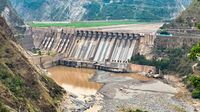Ramban, May 08 (ANI): In a significant move amid escalating tensions, two gates of the Baglihar Hydroelectric Power Project in Ramban district were opened earlier today to manage rising water levels caused by heavy rainfall in the region. This action coincides with India’s recent military operations across the Line of Control, marking a critical moment in the ongoing conflict with Pakistan.
At 1:30 am on Wednesday, Indian armed forces executed a coordinated operation, dubbed Operation Sindoor, targeting nine terrorist camps in Pakistan and Pakistan-occupied Kashmir. The operation, which unfolded in a rapid 25-minute window from 1:05 am to 1:30 am, aimed at dismantling infrastructure linked to terrorist groups, particularly Jaish-e-Mohammed (JeM) and Lashkar-e-Taiba (LeT). Officials stated that these groups have been responsible for orchestrating numerous attacks against India.
The urgency of this military action was underscored by the deadly terror attack that occurred in Pahalgam on April 22, which claimed the lives of 26 individuals, predominantly tourists. In the aftermath, the Indian government has held Pakistan responsible for harboring groups that plan and execute such attacks. The Ministry of External Affairs has publicly declared Pakistan as "a safe haven for terrorists," warning that more attacks against India are imminent.
In a related development, India has decided to put the Indus Waters Treaty in abeyance. This treaty, signed in 1960, governs the usage of the Indus River and its tributaries, including the Jhelum, Chenab, Ravi, Beas, and Sutlej. The Chenab River, in particular, is crucial for Pakistan’s agricultural sector. The decision to suspend the treaty comes after years of complaints regarding Pakistan’s inaction against cross-border terrorism, signaling a potential shift in water management strategies between the two nations.
The Baglihar Dam, inaugurated in 2008, has long been a point of contention between India and Pakistan. Pakistan has raised objections to the dam’s design, alleging violations of the Indus Waters Treaty. However, a neutral expert appointed by the World Bank allowed India to proceed with modifications to the dam. With the recent opening of the dam gates and the suspension of the treaty, the long-standing water dispute appears poised to escalate further.
Moreover, on the same day, one gate of the Salal Dam, also built on the Chenab River in Reasi, was opened. This action, too, was taken in light of the treaty's suspension, raising concerns about potential flooding in Pakistan.
As tensions continue to rise, the implications of these actions are profound. The opening of the floodgates at both the Baglihar and Salal Dams not only serves immediate operational needs but also positions water as a strategic tool in the ongoing conflict between India and Pakistan. The situation remains fluid, with both nations on high alert as they navigate this complex geopolitical landscape.
In summary, the opening of the gates at the Baglihar and Salal Dams represents a dual response to both environmental conditions and geopolitical tensions. As India takes decisive military action against terrorist camps, the suspension of the Indus Waters Treaty further complicates the relationship between the two neighboring countries. With both sides poised for potential escalation, the international community watches closely.





